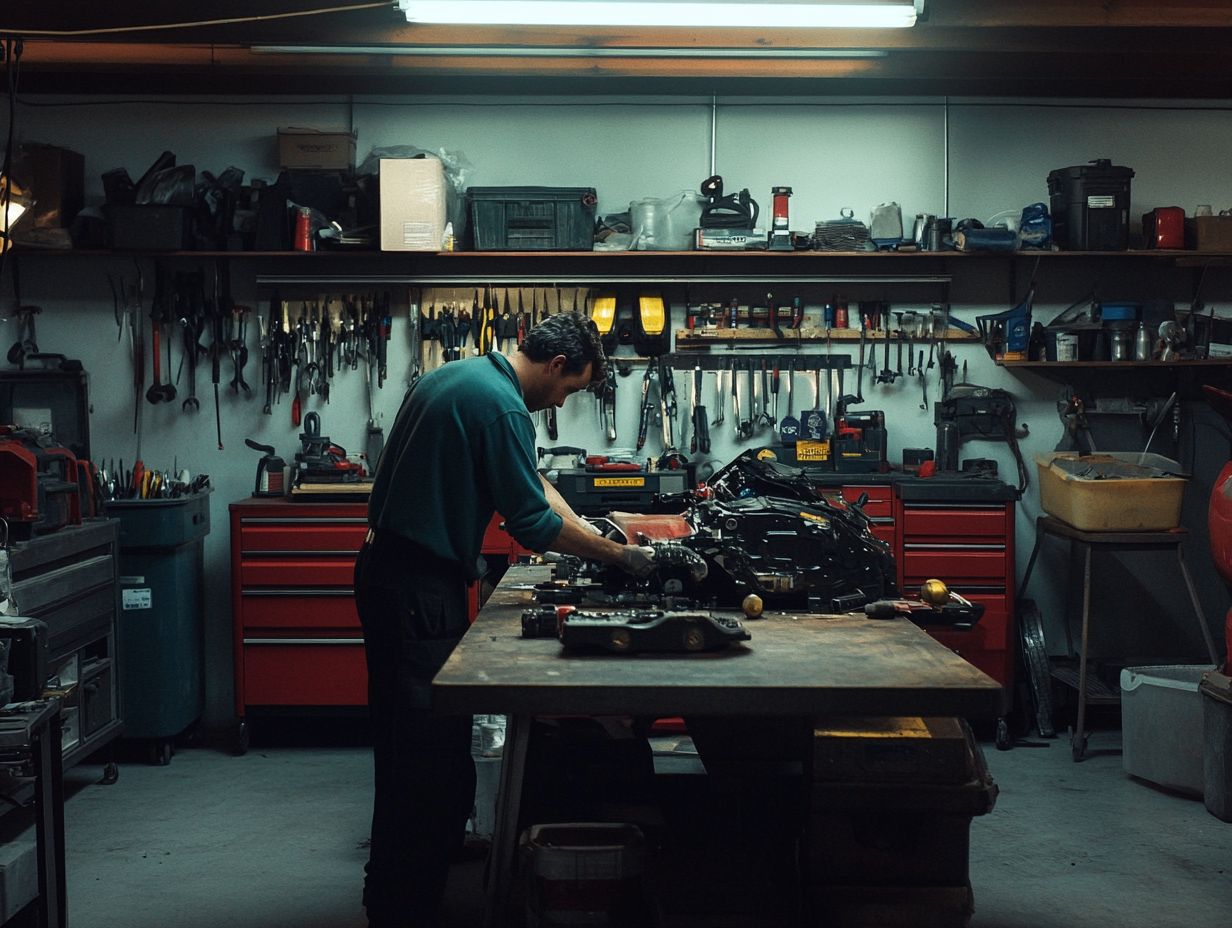Exploring the Benefits of OEM Parts Coverage
Navigating the world of automotive repairs can feel overwhelming, particularly when it comes to selecting the right parts for your vehicle.
OEM parts original equipment manufacturer components are essential for ensuring your vehicle operates smoothly and reliably.
This article delves into the coverage of OEM parts, emphasizing their significance, advantages, and how to secure them effectively.
Whether you seek quality assurance, warranty protection, or cost savings, this guide provides valuable insights to empower you in making informed decisions for your vehicle s maintenance.
Contents
- Key Takeaways:
- Understanding OEM Parts Coverage
- Benefits of OEM Parts Coverage
- How to Obtain OEM Parts Coverage
- Maximizing the Benefits of OEM Parts Coverage
- Frequently Asked Questions
- What s the scoop on OEM parts coverage?
- Why is it crucial to have OEM parts coverage?
- What are the perks of using OEM parts for repairs?
- Is OEM parts coverage included in my standard insurance or warranty?
- How can I find out if my vehicle has OEM parts coverage?
- Are there any drawbacks to using OEM parts for repairs?
Key Takeaways:

- OEM parts provide quality and reliability, making them a valuable investment for vehicle repairs and maintenance.
- OEM parts coverage can offer additional warranty and insurance options, providing confidence and cost savings in the long run.
- When obtaining OEM parts coverage, consider factors such as coverage options, cost, and the provider’s reputation to ensure maximum benefits.
Understanding OEM Parts Coverage
Understanding OEM parts coverage is essential for you as a vehicle owner, especially if you want to ensure the reliability and safety of your car.
Original Equipment Manufacturer (OEM) parts are crafted by the vehicle manufacturer, guaranteeing compatibility with your specific vehicle’s specifications. This coverage not only assures you of the quality of these parts but also plays a crucial role in maintaining safety components and overall vehicle performance elements that are vital for effective car maintenance and the longevity of your vehicle.
Being aware of the differences between OEM and aftermarket parts can enable you to make informed purchasing decisions.
What are OEM Parts?
OEM parts are automotive components crafted by the vehicle manufacturer, tailored specifically for each model and its unique specifications.
These parts are made using the same high-quality materials and processes as the original components, guaranteeing that they meet exact standards for both quality and performance.
By choosing OEM parts, you can maintain the integrity of your vehicle, as these components are designed to fit seamlessly into the existing systems. Additionally, OEM parts are typically aligned with the manufacturer’s warranty conditions, providing you with peace of mind during repairs.
On the other hand, while aftermarket parts may seem more accessible and often come with a lower price tag, they can vary significantly in quality and compatibility. This inconsistency might lead to subpar performance or even safety concerns. Ultimately, opting for OEM parts safeguards your vehicle s long-term reliability, ensuring it operates just as it should.
Importance of OEM Parts Coverage
OEM parts coverage is crucial for your vehicle’s safety, granting you peace of mind as a vehicle owner.
When you service your vehicle with OEM parts, you can trust that they meet the exact specifications outlined by the manufacturer, enhancing both safety and performance reliability.
For example, if you need to replace a crucial brake component, opting for an OEM part can dramatically reduce the risk of malfunction, given that these components are engineered to work harmoniously with your existing systems.
Using OEM parts can also affect your insurance coverage; certain policies may only reimburse repairs performed with genuine parts, potentially impacting your overall costs in the event of an accident. Therefore, as a vehicle owner, it’s wise to balance the benefits of maintaining your warranty against possible future expenses, ensuring you make informed choices that bolster the longevity and functionality of your automobile.
Benefits of OEM Parts Coverage
The advantages of OEM parts coverage are numerous and sophisticated, offering you a blend of quality control, favorable warranty terms, cost savings, and improved performance reliability. You ll love the reliability and assurance!
Quality and Reliability

Quality and reliability serve as the foundation of OEM parts. They undergo rigorous testing to ensure compliance with safety and performance standards.
These quality assurance processes include everything from stress testing to environmental simulations. This guarantees that each component can withstand daily use. By following strict manufacturing guidelines, OEM parts provide exceptional performance and significantly enhance the safety of vehicles on the road.
This commitment to quality leads to fewer repairs and extended longevity for the vehicles they equip. OEM parts are a smart investment for any driver. The precision engineering behind these parts ensures a seamless fit, reducing the risk of malfunctions often associated with aftermarket alternatives.
Warranty and Insurance Coverage
The relationship between OEM parts and your vehicle’s warranty is vital. Choosing OEM components often preserves warranty protection, impacting your auto insurance and coverage options.
When you use OEM parts during repairs, you maintain the integrity of your warranty and meet the expectations that insurance providers have regarding repair quality. This decision can simplify claim approvals, as insurers prefer repairs that follow original manufacturer specifications.
Using OEM components can also increase your vehicle’s resale value. Potential buyers often view these parts as signs of diligent maintenance and care.
Understanding the implications of using OEM parts is essential for protecting your warranty rights and ensuring a smoother insurance experience.
Cost Savings
Cost savings are a major advantage of choosing OEM parts. These components often lower repair costs over time due to their durability and reliable performance compared to aftermarket options.
While the initial investment in OEM parts might seem higher, they deliver better long-term value. Aftermarket parts may seem appealing with their lower price tags, but they often come with hidden costs.
Frequent replacements and potential compatibility issues during installation can quickly lead to increased short-term and long-term expenses, impacting your vehicle’s overall performance. Don t miss out on considering both the initial costs and their impact on maintenance and longevity when making your decision.
How to Obtain OEM Parts Coverage
Obtaining OEM parts coverage requires understanding the available options. This includes exploring direct purchases from dealerships, considering aftermarket parts suppliers, and ensuring that any chosen parts align with your vehicle’s warranty and specifications.
Options for Obtaining Coverage
You have several options for obtaining OEM parts coverage. You can source parts directly from vehicle manufacturers or authorized dealerships. Alternatively, you might consider aftermarket parts that meet OEM specifications.
As you evaluate the best route for acquiring OEM parts, weigh the benefits of each option. Manufacturers generally provide authentic parts guaranteed to meet precise vehicle specifications for optimal performance and compatibility. Authorized dealerships offer similar benefits, often with professional service and warranty assurances.
On the other hand, third-party suppliers may offer more cost-effective alternatives. However, verify that these parts meet OEM standards.
Ultimately, prioritizing compatibility with your vehicle’s specifications and understanding warranty implications will ensure that your investment in parts provides reliability and longevity.
Factors to Consider when Choosing Coverage

When choosing OEM parts coverage, consider several factors: warranty terms, performance reliability, and the reputation of parts manufacturers.
Evaluate the comprehensiveness of the coverage options available. These can range from full replacement warranties to limited guarantees. Assess how these aspects influence your vehicle s long-term performance and integrity.
A comprehensive warranty offers peace of mind by covering repairs or replacements, while a manufacturer s reputation indicates the quality and durability of the parts.
By making informed choices based on these critical factors, you ensure that your vehicle remains reliable and operates at its best throughout its lifespan.
Maximizing the Benefits of OEM Parts Coverage
To truly maximize the benefits of OEM parts coverage, grasp how to leverage it for optimal vehicle maintenance and enhance performance through upgrades. Enjoy peace of mind during your ownership experience.
Tips for Utilizing Coverage Effectively
Follow these practical tips to enhance your vehicle ownership experience with OEM parts coverage. Start by familiarizing yourself with your vehicle’s maintenance schedule and understanding how to file insurance claims.
Regularly consult your owner s manual to adhere to the manufacturer’s recommended maintenance intervals. This helps keep your warranty intact.
Maintain thorough documentation and receipts for all repairs to ensure a smoother experience with insurance companies when navigating the claims process.
Consider the long-term benefits of using OEM parts over aftermarket options. OEM parts come with guaranteed quality and fit, significantly reducing future repair needs.
Take the time to compare prices and warranties to maximize the value of your coverage, ensuring you make the most informed decisions for your vehicle.
Frequently Asked Questions
What s the scoop on OEM parts coverage?
OEM parts coverage refers to a type of insurance or warranty that covers the cost of original equipment manufacturer (OEM) parts for repairs or replacements on your vehicle.
Why is it crucial to have OEM parts coverage?

Having OEM parts coverage ensures that any repairs or replacements on your vehicle use high-quality, original parts from the manufacturer. This ensures your vehicle stays valuable and performs at its peak!
What are the perks of using OEM parts for repairs?
Using OEM parts offers several perks including better fit and function, guaranteed quality, compatibility with your vehicle’s systems, and potential warranty coverage from the manufacturer.
Is OEM parts coverage included in my standard insurance or warranty?
Most standard insurance and warranty plans do not include OEM parts coverage. It is typically an optional add-on or a feature of more comprehensive plans.
How can I find out if my vehicle has OEM parts coverage?
If you’re unsure whether your vehicle has OEM parts coverage, check your insurance or warranty policy. You can also contact your insurance provider or dealership for more information.
Are there any drawbacks to using OEM parts for repairs?
The only potential drawback to using OEM parts is that they may be more expensive than aftermarket parts. However, the benefits of using high-quality original parts often outweigh the cost in the long run.
For more information, review your coverage or contact your dealer. Take action now to ensure your vehicle is protected!






